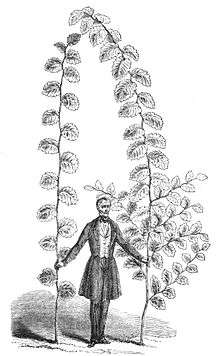''Ulmus'' × ''hollandica'' 'Pitteurs'
| Ulmus × hollandica cultivar | |
|---|---|
 | |
| Hybrid parentage | U. glabra × U. minor |
| Cultivar | 'Pitteurs' |
| Origin | Belgium |
Ulmus × hollandica 'Pitteurs' or 'Pitteursii', probably one of a number of hybrid cultivars arising from the crossing of the Wych Elm Ulmus glabra with a variety of Field Elm Ulmus minor, was first identified by Morren as l'orme Pitteurs.[2] Elwes and Henry (1913) and Krüssmann (1976) listed it as an Ulmus × hollandica cultivar.[3] It was named after the landowner Henri Bonaventure Trudon de Pitteurs of Saint-Trond, near Liege, Belgium, who discovered and first propagated the tree on his estate.
Description
'Pitteurs' was a tall tree, chiefly distinguished by its huge, rounded, convex leaves, < 20 cm long by < 19 cm broad, a little attenuate at the apex and with prominent venation. Kirchner[4] and Petzold,[5] describing a tree by that name from the Royal State Tree Nursery at Sanssouci, noted (1864) that the slightly glossy dark green leaves were obtuse-toothed, and appeared reddish-brown when they unfolded.[6]
 Leaves of 'Pitteurs'
Leaves of 'Pitteurs'
Cultivation
Reputedly one of two varieties grown from seed obtained in 1845 by Henri de Pitteurs[7] of Sint-Truiden or Saint-Trond, near Liege, Belgium, the tree was planted on his estate and along roadsides in the region. Gillekens noted in 1891 that in the areas of Liège and Limbourg, 'Pitteurs' was preferred to 'Belgica'.[8] Augustine Henry thought the tree, which produced shoots growing almost one metre a year, probably identical with those called orme Saint-Trond he saw at Looymans' nursery at Oudenbosch, which he considered perhaps identical when young to a variety of Wych Elm occasionally sold as var. macrophylla.[9] An elm said to be similar and also cultivated on the Pitteurs estate was 'Folia Rhomboidea'.
The Späth nursery of Berlin sold an elm which they said went by the name of 'Pitteurs' in some nurseries but which they themselves called U. hollandica.[10][11]
In 1998 an unsuccessful search of the de Pitteurs-Hiegaerts Estate (now in the public domain and known as the Speelhof park) was mounted in an attempt to rediscover the elm.[12] It is assumed the cultivar fell victim to Dutch elm disease, as did thousands of other elms in the same district. However, 'Pitteurs' was known to have been marketed (as U. montana 'Pitteursi') in Poland in the 19th century by the Ulrich nursery,[13] Warsaw, and so may still survive in Eastern Europe. Several trees were thought to survive near Brighton, England;[14] the only confirmed specimen, however, at the Extra Mural Cemetery in Brighton, was blown down in the Great Storm of 1987. 'Pitteurs' is not known to have been introduced to North America or Australasia.
._Hollandischer_Ruster.jpg) Späth's U. hollandica, "known as 'Pitteurs' in some nurseries" (1920)
Späth's U. hollandica, "known as 'Pitteurs' in some nurseries" (1920).jpg) Putative 'Pitteurs' in the Extra Mural Cemetery, Brighton, blown down in 1987
Putative 'Pitteurs' in the Extra Mural Cemetery, Brighton, blown down in 1987
Accessions
None known.
Hybrid cultivars
'Pitteurs' was crossed with Ulmus × hollandica in the Dutch elm breeding programme before World War II, but none of the progeny were retained.[15]
Synonymy
- l'Orme gras
- ?l'Orme St. Trond
- Ulmus campestris latifolia, foliis rotundata: Morren, Journal d'agriculture pratique 4: 509, 511, 1851.[1]
- Ulmus campestris var pitteursii: Wesmael in Bulletin de la Fédération des sociétés d'horticulture de Belgique 1862: 382, 1863.
- Ulmus scabra macrophylla Hort.: Dieck, (Zöschen, Germany), Haupt-catalog der Obst- und gehölzbaumschulen des ritterguts Zöschen bei Merseburg 1885 p. 82.
References
- 1 2 Morren, Charles (1851). "Nouvelle notice". Journal d'agriculture pratique.
- ↑ Morren, Charles (1848). "Note sur l’Orme-Pitteurs ou orme gras à grandes feuilles". Journal d'agriculture pratique.
- ↑ Krüssmann, Johann Gerd, Handbuch der Laubgehölze (Vol. 3) (Paul Parey, Berlin and Hamburg, 1976); trans. Michael E. Epp, Manual of Cultivated Broad-Leaved Trees and Shrubs (Vol. 3) (Batsford, Timber Press, Beaverton, Oregon, 1984-6), p.410
- ↑ kiki.huh.harvard.edu/databases/botanist_search.php?id=2793
- ↑ kiki.huh.harvard.edu/databases/botanist_search.php?id=2792
- ↑ Petzold; Kirchner (1864). Arboretum Muscaviense. p. 566.
- ↑ Schelev, A. (1854) Annuaire statistique et historique belge, page 325, Brussel - Leipzig
- ↑ Gillekens, Léopold Guillaume, Éléments d'arboriculture forestière (1891), p.40
- ↑ Elwes, Henry John; Henry, Augustine (1913). The Trees of Great Britain & Ireland. 7. p. 1873.
- ↑ Späthbuch 1720-1920, p.263
- ↑ Katalog (PDF). 108. Berlin, Germany: L. Späth Baumschulenweg. 1902–1903. pp. 132–133.
- ↑ Driesen, W. (2008), Stedelijke bibliotheek de Leidrad, Sint-Truiden
- ↑ Ulrich, C. (1894), Katalog Drzew i Krezewow, C. Ulrich, Rok 1893–94, Warszawa
- ↑ Johnson, Owen (ed.) (2003). Champion Trees of Britain & Ireland. Whittet Press, ISBN 978-1-873580-61-5.
- ↑ Went, J. C. (1954). The Dutch elm disease - Summary of 15 years' hybridisation and selection work (1937–1952). European Journal of Plant Pathology, Vol 60, 2, March 1954.
External links
- "Herbarium specimen - WAG.1847114". Botany catalogues. Naturalis Biodiversity Center. Sheet described as U. Pitteursii gigantea, renamed U. hollandica Mill. var. pitteursii Rehder
- "Herbarium specimen - WAG.1911551". Botany catalogues. Naturalis Biodiversity Center. Short shoots. Sheet described as U. hollandica pitteursii / U. hollandica Mill. var. pitteursii Rehder
- "Herbarium specimen - E00824745". Herbarium Catalogue. Royal Botanic Garden Edinburgh. Long shoots. Sheet described as U. montana With. f. hollandica Hort. = Pitteursii Ch. Morren